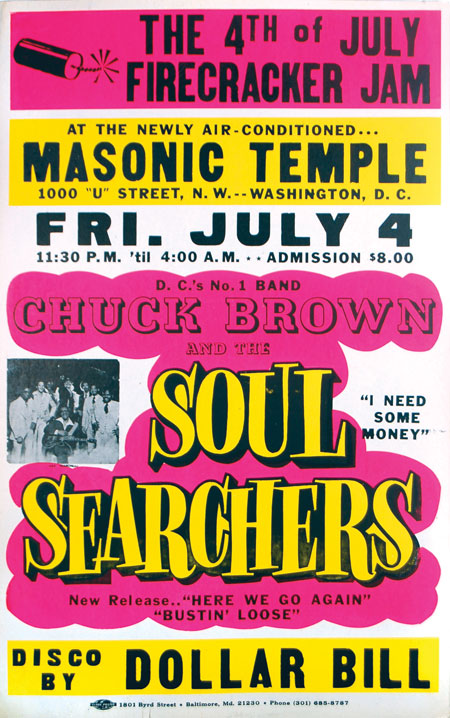Pump Me Up

The champagne corks popped, the flashbulbs sparked and a happy murmur swept through the opening night crowd that filled the columned atrium of the Corcoran Gallery of Art. The silver tureens that held vegan samosas and gourmet mac and cheese were swiftly surrounded, as were the many drink stations. Amidst the commotion it was easy to overlook a small piece of lined paper that hung framed on the wall. Scrawled across it were the original lyrics to Minor Threat’s seminal 1981 single, ‘Straight Edge’: ‘I’m a person just like you / But I’ve got better things to do / Than sit around and fuck my head / Hang out with the living dead / Snort white shit up my nose / Pass out at the shows / I don’t even think about speed / That’s something I just don’t need / I’ve got the straight edge.’ Such incongruities were everywhere, but they only seemed to strengthen this intriguing, if somewhat thin, show that depicted D.C.’s decline and fall and the concomitant rise of its uniquely hermetic subcultures.
Presented in strictly chronological order, ‘Pump Me Up: D.C. Subculture of the 1980s’ displayed photos, videos, posters, album covers and graffiti plucked from the era when D.C. was America’s ‘Murder Capital’. Beginning with archival film footage of the National Guard patrolling the devastated streets following the 1968 race riots, the show dealt with neighbourhood gangs, graffiti crews, murder rates and Marion Barry, the city’s infamous crack-smoking mayor. But at its heart was the rise of two disparate yet contemporaneous music scenes that put the city on the map for something other than urban decay and untimely death: Go-Go and hardcore.
On the face of it, they could not have been more different: Go-Go was distinctly African-American; hardcore was almost exclusively white (the all-black hardcore group Bad Brains, who are well-represented here, were both hardcore’s trailblazers and its greatest anomaly). Go-Go was a subgenre of funk; its songs could last for two hours at a time. Hardcore was a subgenre of punk; its songs barely lasted two minutes. Yet they were similar in one respect: their insistence on the blurring of boundaries between performer and audience. Whether this was achieved through Go-Go’s call-and-response vocals and its insistent shout-outs to local neighbourhoods, or in hardcore’s puritanical insistence on social awareness and a ‘straight edge’ lifestyle, these wildly divergent music scenes sought the creation of a strong community that seemed born out of necessity in a city that was falling apart.
The moment these two disparate scenes briefly coalesced was in 1983, when an attempt to encourage links between hardcore and Go-Go (in the manner of the punk-reggae alliance in Britain’s Rock Against Racism movement) saw Trouble Funk, one of the most popular Go-Go bands, headline a show with Minor Threat at the Lansburgh Cultural Center in downtown D.C. in what was termed a ‘Funk-Punk Spectacular’. Unfortunately, the Corcoran exhibition offers no record or reminiscence of this momentous occasion. All it does have on display is the poster advertising the gig. Fortunately, it is a great poster.
Designed by the Globe Poster Printing Corporation, a now-defunct Baltimore printing house, this and many other Globe posters are on display, all of them a feast of typeface. Globe’s distinctive Day-Glo colours – achieved by hand-printing over a fluorescent silkscreen – advertised Go-Go bands and hardcore bands alike. Its letterpress printing technique seemed fitting for the DIY ethic of the D.C. scene at the time, creating a utilitarian piece of advertising that surpassed its meagre materials and basic production values. It was, if you like, a straight-edge design ethic, the complete opposite to Alton Kelley’s psychedelic Grateful Dead posters.
Ultimately enshrining both hardcore and Go-Go in a museum show is a bit like trying to bottle lightning or starch spandex. Nevertheless, in a city that is rapidly forgetting its past as it is swept along in a much-needed economic boom, the Corcoran should be applauded for seeking to stress its importance. Not least because the museum has just backed away from a controversial decision to move to the suburb of Alexandria in Virginia, a move that would have ironically replicated the ‘white flight’ from D.C.’s city centre that marked the era that the ‘Pump Me Up’ exhibition is chronicling.
There is something vital about this moment in D.C.’s history, when these subcultures – born in garages, front rooms and tiny venues far away from this lavish Beaux Arts building – held within them a desperate yearning to create something to cling to amidst the city’s decay. So vital is it that, if you had staggered out of the opening night party onto the empty Friday night streets of downtown D.C., the pristine obelisk of the Washington monument would have seemed to rise to meet your eye like an immense middle finger.
















